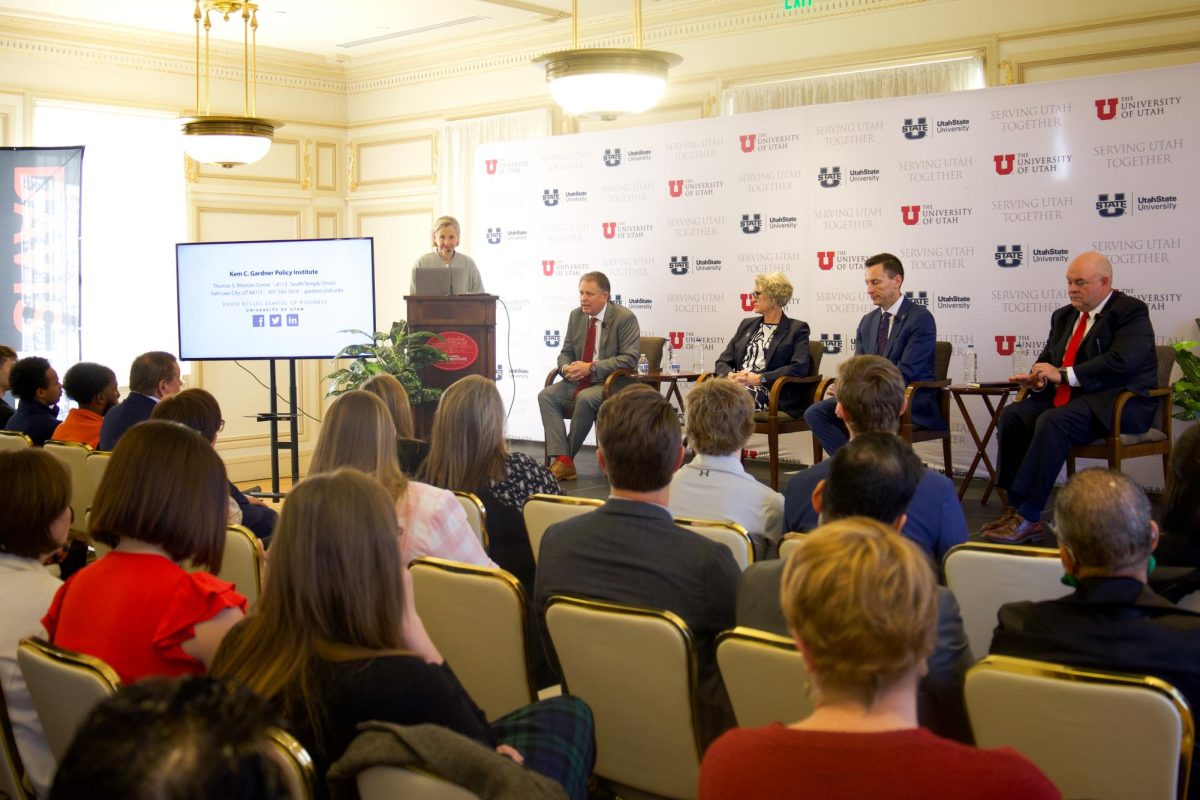The Kem C. Gardner Policy Institute’s monthly Newsmaker Breakfast focused on the importance of higher education in Utah.
The event began with an introduction by Natalie Gochnour, director of the Gardiner Institute and moderator. Laura Summers, director of Industry Research at the Gardiner Institute, gave an overview of the institute’s policy study on the value of higher education.
“Economic data make abundantly clear that post-secondary education improves lives and supports civil society,” the study reads. “Higher levels of educational attainment correlate strongly with increased employment, earnings and upward mobility, all while supporting civil society through increased voter participation, volunteerism and more.”
Summers introduced three key points that can be seen in people who attend higher education, and how it affects their quality of life, upward mobility and the future of their children.
The first point was, “Individuals with higher educational attainment enjoy greater incomes, economic stability and life quality.”
She talked about a correlation between parent’s education levels and the effects it has on their children.
“Utah students with a family member with a postgraduate degree or higher are far more likely to complete post-secondary education for themselves as well,” Summers said.
The second point was that “society derives valuable benefits from an educated citizenry.”
This means that people with higher education have less reliance on public assistance, and are more likely to engage in their communities through voting and volunteering.
According to the policy brief, “Postsecondary degree attainment significantly reduces the use of public assistance among Utahns, including one study that found nearly half of graduates with bachelor’s degrees that previously used [Supplemental Nutrition Assistance Program] never participated in SNAP again.”
The third point was, “Higher education benefits Utah’s economy through job and business creation, workforce development, and innovation.”
The study said there are widespread economic benefits that higher education has, including providing 130,000 jobs statewide for Utahns.
The presentation also included a look at the economic contributions of higher education to the state as a whole.
Utah has eight degree-granting public universities and colleges. Representing four of them, panelists at the event consisted of President Taylor Randall of the University of Utah, President Brad L. Mortenson from Weber State University, President Darin Brush from Davis Technical College and President Elizabeth Cantwell from Utah State University.
Randall said he has always been appreciative of higher education, and its “remarkable transformational power” in individuals. He added ideas in the minds of the next generation are what motivates him with higher education.
“Numbers are great, and it bears out but it’s really the ideas and the passion underneath it that are driving all of those results that you see,” he said.
Mortenson said that he sees a lot of value in higher education, due to how the community has embraced Weber State over the years.
“We know that Ogden rose up to keep an institution in their community at that point in time, so we have this deep commitment to, we need to reciprocate that back to the greater region like our other institutions do across the state. We have a lot of programs that reach out and serve our community.”






John Hedberg • Feb 15, 2024 at 1:25 pm
Students are racking up ruinous debt from out-of-control education costs, so that none of us can look forward to forming a family and buying a home before we hit 35. The University charges 3 TIMES as much as Salt Lake Community College for the exact same classes (check their respective course catalogs and the rate/fee schedules: on top of ridiculous tuition rates, the U ‘offers’ zero-credit tuition rates before any credits are taken, 14 “mandatory fees”, plus supplemental fees like a “science differential”, e-text fees, program fees, and even a “success fee” which is somehow not included within tuition). BTW, both schools operate in the same county with the same cost of living, and SLCC fields multiple campuses. I can take 18 credits at SLCC at the same price I would pay for 4 credits here at the U.
Suggestions:
1. Immediately adopt the SLCC tuition/fee schedule here at the U, with maybe a 25% increase above SLCC prices to cover higher salaries for educators, which will still only be about half what U students pay now, and freeze these rates for the next five years. The State Legislature can provide any funding gaps that can’t be made up in other ways, since nothing is more important to Utah families than the education & professional success of the state’s future parents, leaders, and entrepreneurs.
2. Raise bonds and construct 3 new large-capacity parking structures, one just West (downhill) of Rice-Eccles Stadium, another just North of the Student Life Center & the HPER Complex (put the Impact & Prosperity Center on top of it?), and a final one just North of Merrill Engineering. This will provide students easy access to 3 strategically located landing-points that provide easy walking to most classes and recreational facilities. Charge a dollar a day to park, and put solar panels on the roof, so these can pay for themselves and provide upkeep.
3. Provide online options for most classes to commuters, which are much less expensive to the University, and yet will still provide easy access for the many off-campus students who work and have other responsibilities that make public transportation time consuming and impractical.
Just some thoughts which might improve the value of higher education in Utah~